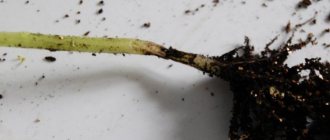Why do tomatoes in jars turn cloudy?
Even when using reliable and time-tested recipes, you cannot be one hundred percent sure that the preserves will not begin to deteriorate. There are several common reasons why tomato brine becomes less transparent.
These include the following:
- the use of low-quality tomatoes that show signs of rot;
- poor washing of vegetables used for canning;
- use of unsterilized glass jars;
- poorly closed jars into which oxygen gradually penetrates;
- failure to comply with proportions and adding a large amount of vinegar or salt.
Reasons for cloudiness of workpieces
Even if you use the most proven recipes for preparing cucumbers and tomatoes, you cannot exclude the possibility that the liquid in the jar will lose its transparency, the vegetables will lose their elasticity and taste, and the lids may even swell. This can be caused by non-compliance with the technology for preparing canned foods. The main reasons for damage to winter preparations are:
- Poorly washed or damaged vegetables;
- Insufficient sterilization of lids and jars;
- Cans that are not rolled tightly enough;
- Failure to comply with the proportions specified in the recipe or substitution of ingredients;
- Failure to comply with temperature storage standards.
Even one of the listed reasons may be critical when preparing pickled cucumbers or tomatoes. To prevent such detrimental consequences for products, it is important to clearly know how to prevent it.
Is it possible to eat tomatoes in cloudy brine?
Many people whose tomatoes have turned cloudy after canning are wondering whether such tomatoes can be eaten.
Cloudiness of the brine in the jars indicates that the fermentation process has begun. Pickled vegetables cannot harm the human body and therefore can be eaten if desired.
However, you can eat them only if the lids on the jars are not swollen. If they begin to swell, it means botulism is developing. Such preservation is contraindicated, since E. coli actively develops in them, which is harmful to humans.
Why should you be careful?
If enough vinegar was not used when preparing canned cucumbers for the winter, this will lead to the formation of lactic acid in the jars. In this case, the cloudy jar should be placed in the walking chamber for about a week. During this time, the sediment will sink to the bottom, and the vegetables can be used to prepare various dishes.
If, in addition to cloudiness, you notice that the lid is swollen, this means that the pickles cannot be used for food. The container has already undergone the process of reproduction of harmful microorganisms that can be dangerous to your health.
In order not to be faced with the choice of throwing away food or preserving again, you need to approach this process with special preparation and care. Add hot peppers and horseradish leaves to the marinade, which will help prevent the growth of bacteria.
What to do if the brine becomes cloudy: rework the cloudy preparations
Pickled tomatoes that have begun to turn cloudy should not be thrown away immediately, as they can be remade. To do this, it is recommended to open all containers with tomatoes and move them to a cool room where there is no sunlight. They need to be kept in such conditions for about a week and a half. If after this the brine is no longer cloudy, the tomatoes are canned again and transferred to the cellar for storage.
See also
15 best step-by-step recipes for preparing zucchini for the winter
Read
To do this, perform the following steps:
- Get the vegetables. First, the tomatoes are removed from the container, rinsed with water and transferred to the salt liquid.
- Drain the brine. After removing the vegetables, you need to drain the cloudy brine, and also sterilize and wash the container.
- Preparing the marinade. A new marinade is poured into the cleaned jars along with the tomatoes, after which the containers are rolled up with lids.
Methods for sterilizing jars
To make canned tomatoes tasty, you need to prepare the lids before sterilizing the jars. They must be without any irregularities in shape or obvious flaws, and must not contain scratches, rust, etc.
With a new sponge or rag you need to wipe the jars and lids with a soda solution or detergent. Then rinse well with running water.
The sterilization stage can take place in various ways.
For a couple
The pan is filled with water (half the capacity) and brought to a boil. The lids are lowered into the boiling water, and a colander or wire rack is placed on top (on top of the pan). For thorough sterilization, jars are placed on a wire rack with the neck down.
Some housewives have a sterilizer with holes for dishes in their home. You can use this device to facilitate steam disinfection.
How to avoid cloudiness of the preservation in the future?
There are several recommendations that must be followed to prevent seaming from becoming cloudy in the future:
- Carefully sort through the tomatoes. All tomatoes that will be canned are sorted. This is done to get rid of rotten vegetables.
- Sterilization. To reduce the likelihood of the brine becoming cloudy, you need to sterilize the container.
- Careful twist. The canned food must be rolled up in such a way that the neck is thoroughly closed. At the same time, there should be no cracks on it through which air could enter.
Cans of tomatoes exploded: what to do?
Most often, the blanks deteriorate because excessive gas formation occurs inside the can. It occurs when the marinade preparation technology has been violated or the utensils have been insufficiently sterilized. It’s not uncommon for tomatoes to “explode” due to poor-quality lids or poor screwing of them.
To avoid troubles with preservation, it is best to choose the most reliable method of sterilizing jars - heating them in the oven at 100 degrees. The lids can be boiled for several minutes with boiling water, and when rolling, turn the machine well (to the end). After screwing the cans, be sure to turn them upside down and store them for a day under a blanket.
Tomatoes can also “explode” because there is dirt left on the vegetables for twisting (it can also contain a lot of bacteria and fungi). To avoid fermentation, each tomato, herbs and garlic clove must be thoroughly rinsed with hot running water. Roll up the tomatoes by preparing the “correct” marinade with enough vinegar and salt. After all, they act as natural preservatives, which preserve vegetables.
IMPORTANT: Even if the tomatoes in the jar have not become cloudy after a day, the preservation should be monitored for a few more weeks (2 or 3). To eliminate the risk of tomato fermentation, store your canned food in a cool place (basement, cellar, balcony), because in a warm room the risk of clouding and exploding cans is much higher.
If you notice even a little foam in the jars, such preservation should be immediately opened and re-rolled. After any preservation, even if you put the jars in a cool place, check the lids for swelling for the first month. This is quite simple to do - knock on the lids: a ringing sound symbolizes a good and reliable seaming, a dull sound foreshadows imminent swelling.
If the lids swell, such preservation should be stored in the refrigerator. This may slow down the fermentation process, but if this does not happen, the jars need to be opened (fresh tomatoes can be re-canned, but “old” ones can be eaten if they still have a suitable taste). The situation is much worse when mold is visible in the jars. Such preservation only requires throwing it away, because fungus has grown inside.
IMPORTANT: However, it is better not to eat exploded and moldy tomatoes, since the jars may contain E. coli - the very reason for the fermentation of the twists.
What to do with swollen tomato cans?
How to save cloudy workpieces
A cloudy marinade is a bad sign. It may not contain pathogenic bacteria, but rotting products can disrupt the activity of the gastrointestinal tract. As a general rule, marinades that have lost transparency, despite the swelling of the lids, are thrown away.
Note! Under no circumstances should you wash questionable vegetables and then add them to hodgepodge or pickle soup.
It is also inappropriate to heat treat spoiled canned food. You need to carefully inspect the jar, and if there is no swelling of the lid, proceed to restore the product.
Getting rid of cloudy sediment
If you preserve tomatoes correctly, you can avoid unpleasant sediment. If turbidity appears in the contents of the jar, you can correct the situation with simple steps:
- pour the brine into a saucepan;
- boil the brine for at least 5 minutes;
- add a tablespoon of vinegar, pour the improved brine back into the jar with the vegetables;
- Re-roll the canned food and leave it to cool on a towel, neck down.
The method does not give a 100% result; it works in case of cloudiness of the brine without swelling of the lid. If the lid is deformed, it is impossible to save the brine from sediment.
The jars are swollen, the brine is cloudy: is it possible to save the preserved food?
Fourteen years ago, being in an “interesting situation,” I somehow wanted salty pickled tomatoes. Well, a classic of the genre - “craved something salty.” I remember that I then took out the last single jar from my supplies and, although the slightly cloudy brine confused me (the lid didn’t swell!), I “filled” half the jar in an hour.
The tomatoes tasted normal, a little “smelly”, but quite edible, and I attributed the “sourness” effect to pregnancy; during this period a woman’s nose becomes her enemy. Oh, and then I was rinsed after that “salty” drink, sorry for the details! Since then, I’m not a fan of pickled tomatoes at all, and even more so if the preparation looks spoiled.
Although this fact does not bother many people at all. Is the brine cloudy or the lid swollen?
This means you need to quickly open the jar and eat the contents before the canned food is completely gone. Is it possible to do this, will it not harm your health? Let's figure it out.
What to do if the brine in cucumbers becomes cloudy
The main reasons for cloudy brine in cucumbers. Possible ways to prevent and resolve this problem.
A very common and favorite home-made winter preparation is cucumbers. Pickled and salted, assorted and filled with various original brines - there are so many recipes that housewives can come up with to diversify their table and enjoy crispy cucumbers all year round.
In this article I would like to answer all of the above questions.
Why are cucumbers in a jar soft?
If cloudy brine, foam appears, or if the jar “explodes,” the cucumbers themselves will most often change. They will become soft and sometimes even mushy. There are several reasons for this.
Why do cucumbers become soft in a jar?
- The fermentation process has begun due to poor sterilization or a violation of the cooking technology.
- The seal was broken and air got under the lid of the jar.
- If the preservation has been in the pantry or basement for a long time, the cucumbers automatically become softer due to the “work” of enzymes.
- If only the cucumbers at the bottom have become soft, then the pressure from the upper mass is to blame.
- Incorrect weight ratio of cucumbers and brine. This happens when vegetables are not packed tightly.
- The preserved jars were kept in a warm place for a long time.
- The wrong variety of cucumber was chosen. It is better to give preference to small cucumbers with pimples and rich color. They must be collected no earlier than 24 hours before seaming.
- Insufficient amount of spices and herbs.
What to do if the cucumbers become cloudy? secrets of proper preparation of pickled cucumbers
You are here: » Cooking » Winter preparations » What to do if the cucumbers become cloudy? Secrets of proper preparation of pickled cucumbers
Conservation is the pride of every housewife. Pickled cucumbers, salted tomatoes, lecho, caviar, confiture. It is impossible to list the variety of home-canned vegetables and fruits. But yesterday the jars stood beautifully in the cellar, and today they became cloudy. What to do if the cucumbers become cloudy? This is what we have to find out.
Canned cucumbers have become cloudy - what to do?
Situations arise when it is not the solution that becomes cloudy, but the canned cucumbers themselves. This is a normal sign if it occurs the first day after salting. However, if this effect lasts more than 4 days, then the product is considered spoiled.
First you need to taste them. Naturally, this needs to be done in small quantities. If cucumbers are bitter, it is better to throw them away, otherwise consuming them can harm human health. If the taste is normal, then you can try to over-salt them.
We suggest you read: How to grow good cucumbers in a greenhouse
This requires:
- Open the damaged jar;
- Drain the marinade into a saucepan;
- Get the cucumbers;
- Rinse them with warm water;
- Place back into jar;
- Pour over the heated marinade.
Sometimes the cause of cloudy cucumbers is the preparation of the wrong marinade. Therefore, to improve the effect, it is advisable to prepare a new brine.
Pickled cucumbers have fermented, become cloudy, the lid is swollen: what to do, how to save it, how to remake it?
Saving marinades
Not everyone, even the most avid lover of pickles, will decide to try vegetables that have been in a cloudy solution for a long time.
https://www..com/watch?v=bypNAI4e7ks
Since a cloudy marinade indicates improper preparation of the product, which, at best, will lead to a change in the taste of the product: the cucumbers will become soft and sour, at worst, the lid will soon swell or completely break off, and the cucumbers will become unsuitable for consumption.
Therefore, in order not to regret the time wasted preparing a snack, when the above signs appear, we take urgent measures:
- Open the jar of cucumbers
- Pour out the brine
- We wash the cucumbers with warm boiled water without removing them from the container.
- Pour boiling water over vegetables
- Let sit for 5 minutes, covering with a lid.
- Then pour the water into a saucepan and bring to a boil.
- Pour salt and spices into the jar according to the chosen recipe
- Roll up cucumbers
- If desired, salt can be poured not into a container, but boiled with water
Not everyone likes this widespread method; many craftsmen have gotten used to using their own, proven methods:
- Do not open the jar with a swollen lid, just pour a large handful of salt on it. After some time, the lid will lower and the brine will become transparent. The cucumbers will acquire a slight sourness, but you won’t have to open the jar and over-salt the vegetables.
- Marinade prepared with the addition of 3 tbsp does not change the taste of cucumbers. vodka. But to do this, you will have to do the above manipulations with opening the jar and salting the cucumbers.
- Often the jars begin to “play” and the lids swell. To calm them down while still retaining all the flavor of the cucumbers, use a can opener to release a little air. But be very careful so that the lids and rubber seals remain intact. Fermentation will end and the lid will snap into place.
- A very simple method, from our grandmothers: pour tomato juice over completely exploded cucumbers. This method makes the vegetables very crispy and tasty. Helps even in the most hopeless situations.
Why cucumbers in jars turn cloudy after seaming and explode: reasons
photo of jars of pickled cucumbers in which the brine has become cloudy
There are a number of reasons for the cloudiness of the brine in jars of cucumbers that you have safely prepared for the winter:
- depending on conservation technology
- independent of her
Let us designate the reasons from the new category:
- Preparing cucumbers and greens. The more thoroughly and carefully you wash and clean the ingredients for home canning, the more likely it is that the brine will not become cloudy. Please note that you should rub the cucumbers more diligently, for example, with a brush. Then no dirt will start the process of rotting under the lid.
- Vinegar or citric acid. They ensure the preservation of an acidic environment, which is hostile to the growth of putrefactive bacteria. But due to violations in proportions, the relationship with salt and sugar, and the use of an expired product, there is the formation of turbidity in canned jars of cucumbers.
- Salt. Use only table salt for winter preparations. Iodized and marine contain impurities that can disrupt the transparency of the cucumber brine.
- Preparing the marinade. Experienced housewives recommend boiling it twice and adding vinegar immediately before twisting the jars.
- Selection, washing and processing of jars. Carefully select jars for canning. The best candidates are those with no chips or cracks on the neck. Wash with products that can be easily rinsed with cold water. The ideal option is baking soda. Sterilization with hot steam is also required. And if you also boil jars of herbs and cucumbers in hot water, then their chances of surviving until winter without becoming cloudy will definitely increase.
- Covers. Check them after unpacking for soft rubber. If it is hard, replace it with others. Before rolling, treat them by dipping them in boiling water for 3 minutes. The advice also applies to screw caps.
- Seaming device. It happens that due to time, it wears out and its parts stop working correctly. Then the problems of lack of tightness and poor fit of the lid to the neck of the jar are inevitable.
- Process before sealing with lids. If you practice pouring boiling brine over cucumbers and herbs placed in jars 2-3 times, you significantly increase the chances of preservation reaching the desired date without clouding the liquid.
We suggest you read: Propagation of thuja by cuttings in summer
The second category of reasons is poor quality products. That is, there is an excessive content of nitrates in cucumbers, which remain even after soaking in cold water. Or if you decide to roll up early varieties of cucumbers for the winter. They are also not suitable for this kind of work.
As a result, your cloudy jars of cucumbers may begin to explode. The reason is an increase in the concentration of lactic acid and waste products of putrefactive bacteria, an increase in the number of the latter. In other words, carbon dioxide finds its way out only through the lid. Although there are times when the bottom of the jar breaks.
Is it possible to eat pickled cucumbers in cloudy brine?
Is it worth the time to re-salt exploding marinades?
There are a lot of radically opposing opinions about eating such products: from various recipes to throwing them away without a second thought.
And yet, most housewives are inclined to this conclusion:
- Cucumbers whose brine has become cloudy cannot be restored when sealed tightly with a lid.
- After the bombing, it is strictly forbidden to use the spoiled product for food. This can lead to severe poisoning. In this case, you shouldn’t even speculate about why the cucumbers turned cloudy. Just throw them away.
- But vegetables prepared using the salted method, that is, closed with nylon lids, can be restored using the above methods.
Is it possible to eat cucumbers from cloudy brine?
If all stages of the preparation have been completed correctly and the lids have not swelled and the brine has become cloudy, this only means that ripening has begun, during which lactic acid is formed. This often happens with salted vegetables rather than pickled ones, that is, with those for which vinegar is not added.
Lactic acid is a natural preservative, which is also very beneficial for the human body. It improves blood circulation, reduces blood pressure and controls blood fat levels. Thus, if sediment appears, but the lid is intact and there are no air bubbles in the liquid, the product can be eaten.
We invite you to familiarize yourself with the Shelf life table for products.
If the water becomes cloudy and the lid swells, such vegetables, unfortunately, cannot be saved. A swollen or already torn lid may be a sign of the presence of botulism bacteria. Of course, this cannot be determined without laboratory tests. But is it worth the risk if there is a possibility of contracting such a dangerous disease?
A few tips for salting
You can watch a video in which Elena will tell you a recipe for pickling delicious cucumbers in a jar:
Experienced housewives claim that if you first remove all microbes from the container, the cucumbers will not become cloudy. To do this, you need to completely fill the jar with boiling water and close it with a lid for 10 minutes. All bacteria that were in it will die.
You should also check each cucumber before pickling. If you get at least one rotten fruit in the container, the entire marinade will quickly become cloudy.
Cooks also say that it is necessary to select a recipe for each variety of cucumbers; only in this case can you get a tasty, crispy product.
Canned cucumber rescue service
And then you noticed - the brine in the cucumbers became cloudy. What to do? Try to immediately determine the cause. There is always a cause-and-effect relationship. Only then can conservation be rehabilitated.
Such cucumbers cannot always be eaten. Sometimes it's better not to risk your health and throw them away. And if the cucumbers have not lost their shape, have not softened and do not emit a specific putrid odor, try to save them.
You can do this in several ways:
- This method can only be used if the brine becomes cloudy literally 2-3 days after preservation and the lid does not swell.
Open each jar and drain the cloudy brine. Pour boiling water over the cucumbers. Now you can go the following way: boil the cloudy brine, add table vinegar and re-roll the jars. But it is better to prepare a new brine and repeat the canning process. - Lactic acid can often be the culprit behind brine cloudiness.
In this case, we place the jar of cucumbers in a cool place, preferably a refrigerator, and monitor it for a week. As practice shows, the sediment will remain at the bottom, and the brine will become clear again. Such cucumbers will have a specific taste, so they can only be used for making pickle sauce. - If the lid of the jar bulges, open it immediately and throw away the cucumbers. They cannot be eaten. The presence of a swollen lid indicates that bacteria and harmful microorganisms have settled in the jar next to the cucumbers. Once in our body, they can become responsible for the development of ailments of the digestive tract.
Note to the hostess
Many housewives who have read advice about cloudy brine think that such cucumbers can be used as food. But each case is individual for each organism.
Therefore, you need to think carefully before consuming them. If you suspect that a jar of cucumbers is spoiled, then throw them away and don’t joke with your health.
Think about the fact that health is more important and you can’t buy it.
Source: https://teatr-satiry.ru/chto-delat-esli-pomutnel-rassol-v-ogurtsakh/
Note to the housewife - what to do if the brine becomes cloudy?
Many housewives, before and now, are engaged in home canning. And, although there is now no shortage of such goods in stores, there is nothing better than vegetables rolled at home.
In production, a large amount of vinegar is necessarily added to the brine, and it is impossible to drink it. Moreover, they sell not canned, but pickled vegetables. And what could be better than a mug with it in the morning, after the holiday.
Therefore, every woman has her own unique pickling recipe, which, as a rule, is passed down from generation to generation.
But when canning cucumbers, the problem of brine cloudiness arises. This can happen with several cans or with an entire batch of freshly sealed canned goods. What should I do to avoid this?
Reasons for solution turbidity
• Unsterile jars or poorly washed vegetables • The lid is not tightly closed
• Violation of the conservation procedure
Lactic acid or botulism?
If the brine is cloudy, but the lids are not swollen, the formation of lactic acid (milk fungus) has begun in the canned food. It's not scary. It only means that the fermentation process has begun.
This type of acid is the only natural preservative. As it accumulates, it stops the development of other bacteria. And for the solution to become transparent again, it is enough to put the jars in a cold place: a cellar or refrigerator. The turbidity will settle to the bottom in a white coating. The cucumbers, of course, will not be crispy and will lose their attractive appearance. But for a salad or pickle, they are quite suitable.
If the lids are swollen and the brine becomes cloudy, then there is nothing to do - you need to throw out the canned food. Because it is life-threatening. Bloating is a 100% sign of botulism. The causative agent of this disease is microbes – anaerobes. They develop only in the absence of oxygen (canned food) and affect the central nervous system, which can be fatal.
In the natural environment, spores of these bacteria live in the soil, with which they end up on vegetables. Microbes die only at temperatures above 120 degrees, and at 100 degrees they are viable for several hours. Large amounts of salt and vinegar are absolutely safe for them. You can fight them only by boiling the product.
How to sterilize jars?
Lack of sterility is one of the most common causes of brine cloudiness, especially among beginners. It is not enough to hold it under hot water and wash it with soda. Sterilization is necessary to remove all microorganisms. This procedure can be done in several ways.
For a couple
This option was also used by our grandmothers. Water is poured into the pan, brought to a boil, a grid with jars is placed on top of it, bottom up. The procedure lasts depending on the volume of the container: from 10 to 30 minutes.
Boiling
A more reliable method of sterilization than the previous one. The procedure is the same, only the jars are placed not on a wire rack, but in boiling water. You need to lower them into the liquid gradually so that the glass warms up evenly and does not burst due to a sudden temperature change. The boiling time is the same.
In the microwave
If the jars are large enough to fit into a microwave oven, then you need to pour some water into them and “cook” for 5 minutes at a power of about 1000 watts, until the liquid boils.
In the oven
A fairly simple method, since there is no limit on the size of the container. To sterilize jars, the oven is heated to 150 degrees. The process takes from 15 to 25 minutes.
By carrying out one of the above procedures, you can be sure that the canned brine will not become cloudy.
When sealing cans, it is better to use an autoclave. It provides reliable tightness. You should not buy jars with screw caps. After all, air can get into the slots, which will lead to cloudiness of the solution. Or cans that contain air may “explode.”
Getting rid of cloudy sediment
- You cannot reduce or increase the proportions of the components of the salting solution.
If you add more dill, the brine will become cloudy. Reducing the amount of salt or vinegar will have the same effect. Or the absence of the latter. In addition to its unappetizing appearance, it can be hazardous to health. - Jars that are packed too tightly or a lot of different herbs (currants, dill, etc.) can cause a cloudy brine to appear.
Experienced housewives, in addition to cucumbers, add tomatoes or peppers to the jars - in this case the liquid will remain transparent - A proven way to get rid of cloudy brine is boiling.
To do this, you need to open the jars with cloudy brine, wash them, sterilize them, remake the solution and preserve the vegetables again. Boiled liquid needs to be poured twice - In addition to cucumbers, a cloudy solution can occur when fermenting vegetables: cabbage, carrots and the same cucumbers.
In this case it is the norm. After all, lactic acid works. When pickling mushrooms, you can also encounter this problem. Method of struggle: pour out the mushroom solution, boil it, adding peppercorns, bay leaves and salt. Let it simmer, cool and pour over the mushrooms again.
To sum it up, we can say this: do not ignore the rules. By saving time now, you will spend much more of it later. This is the best case scenario. And at worst, you risk your health and that of your loved ones.
Therefore, when starting to make canned food, thoroughly wash and sterilize the jars, rinse the vegetables only under running water, and add the required brine components in the specified proportions. To seal, use an autoclave. And you won’t face the problem of cloudy brine.
Date: 2015-01-24
Source: https://DelaiSmelo.ru/kulinariya/pomutnel-rassol-chto-delat
Is it possible to eat cucumbers from a cloudy jar?
Cloudy canned cucumbers for the winter are not always a consequence of the fact that bacteria dangerous to health have appeared in the liquid. Before deciding whether such a product can be eaten or thrown away immediately, you need to analyze the following information:
- what is the degree of thickness of sediment in the liquid;
- How many days after preparing the preparation did the water begin to change its color?
- Is there any swelling in the area of the lid?
If the liquid has not changed so much that vegetables are not visible in it, the lid has not lifted, and the sign itself appears 2-4 days after preparation, the cucumbers are edible, but only after additional heat treatment.
Cucumbers that were in a whitish liquid are best subject to additional processing, for example, used for soups
The jar is opened, the cloudy liquid is poured out, the vegetables are placed in another, clean container and stored in the refrigerator. It is still not recommended to use them in this form, but they can be used for making soups, for example, brine.
If the cucumbers turn sour or mold appears on them, then you should not consume such products. Also, pickles that have exploded should not be consumed. If, when canning with citric acid or vinegar, the greens in the jar became darker, and after a few days they turned white, then the products are quite suitable for food.
It’s better not to take risks, but to open the jars and eat lightly salted products. If cucumbers do not emit an unpleasant odor and are not bitter, they can be used to prepare pickle soup, solyanka, and sauces for meat dishes.
How to properly cover tomatoes for the winter so they don’t explode: secrets, tips
To ensure that canned tomatoes do not spoil and are always tasty, it is important to adhere to 7 main rules:
- Rule one: “Sorting through vegetables.” To do this, you should sort through the vegetables, choosing the most elastic and intact ones, without damage, dents, darkening, and not rotten.
- Rule two: “Preparing vegetables.” To do this, each fruit should be washed with water (preferably hot), you can also do this with a weak solution of salt and soda.
- Rule three: “High-quality sterilization.” To do this, you should rinse the jars with soda and heat them in the oven, and it is advisable to boil the lids.
- Rule four: “Natural preservative.” It must be in the marinade. Use salt, vinegar or citric acid.
- Rule five: “Infusion in the marinade . Place the prepared vegetables in sterile jars and pour hot brine over them, letting them steep for about 15-20 minutes. The brine can then be drained, re-boiled and refilled.
- Rule six: “Correct twist . Make sure that the neck of the jar is intact and without cracks, roll it up very tightly until the last turn of the machine (this will create a vacuum in the jar and prevent fermentation).
- Rule seven: “Store in a cool place . To avoid lid swelling, fermentation and jar explosion.
Correct twist of tomatoes
Why do jars become cloudy after packing cucumbers?
The process of preserving any vegetables for the winter has its own sequence and a clear algorithm. This also applies to rolling cucumbers. An experienced housewife knows that it is better to stick to a proven recipe to avoid unpleasant surprises. One of these is that jars of cucumbers become cloudy. “Wrong lunar day” or “Cucumbers let us down” - many will think. But everything is a little more prosaic.
The main reasons why jars become cloudy after seaming cucumbers:
- The jars are poorly washed. Accordingly, the fermentation process begins in the brine. As a result, a coating appears on the surface of the jar.
- The sterilization process was performed incorrectly. It should be noted that some recipes do not imply sterilization at all. And the result comes out great. But if the hostess nevertheless began this procedure, it should be performed according to all the rules (withstand the duration, temperature conditions, etc.).
- Cracks on the “neck” of the can. This causes air to get into the middle and trigger the fermentation process. This can also include another reason - poorly tightened lids.
- Iodized salt may cause the liquid to become cloudy. This will cause cloudy streaks to appear on the glass jar.
What to do if the brine is cloudy and the lid is not swollen
Cloudy brine is a sign of the fermentation process that has begun after seaming. If there is no swelling, and the liquid in the jar begins to become cloudy, then the logical option is to restock the canned food. Experienced housewives on the forums suggest what to do if the tomatoes become cloudy in the jar. In fact, there are two ways to solve the problem.
- Restart. You need to drain all the brine without any residue, and boil the tomatoes again. Only after these procedures, re-sterilization of the jar and recalculation of the proportion of vinegar, salt, sugar, can the marinade be re-rolled.
- Recycling. If the new process of preparing the product does not inspire enthusiasm, then you can process canned tomatoes into lecho, by pickling, or use them for food as soon as possible.
Attention! An unpleasant odor and sour taste are a serious reason not to consume products from an opened jar. Of course, it’s a pity for the work and effort, but health is more valuable.
Tips for properly canning tomatoes
As you know, you can can or marinate different tomatoes, both green and red, large and small. But it is necessary:
- adhere to the recipe and proportions depending on what type or variety of tomatoes are being prepared for the winter
- choose healthy and unspoiled fruits
- carefully observe the rules of cleanliness during the canning process, including cleanliness of hands
- follow the rules of sterilization, including after rolling up jars
- try to carry out the so-called quarantine aging of cans with the finished product before arranging them for winter storage
Careful selection of products and adherence to preservation technology is what is needed to ensure that tomatoes last a long time.











